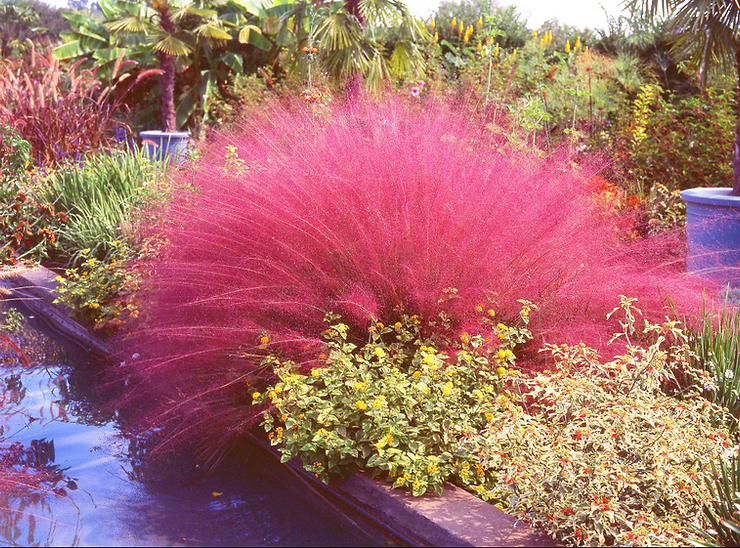There is nothing more graceful and calming than beholding the soft sways of tall ornamental grasses free-flowing in the wind. It awakens all your senses, from the peaceful swishing sound to the beauty of the majestic plumes billowing above towering stalks. In this post you will learn how, when, and where to add these glorious additions to your existing landscape. Read on to learn a bit about landscaping with ornamental grasses. I will also recommend a few of my favorite varieties.
“Some of the links within this post are affiliate links on which I receive a small compensation from the sale of certain items with no extra cost to you.”
“As an Amazon Associate I earn from qualifying purchases.”
How to Select the Perfect Grass For Your Area
You need to keep in mind a few things when selecting ornamental grasses.
1. Cool Season or Warm Season Grasses?
When selecting your grasses for your landscape, keep in mind the two types of grasses. A cool season grass is usually smaller. The tallest cool season grass is the Feather Reed Grass that grows 4 to 5 feet tall, however most cool season grasses grow to about 10 inches. They mature quickly and are semi-evergreen. Cool season grasses will have rapid growth in the early spring when air and soil temperatures are cooler. They bloom in the early summer.
Warm season grasses are late bloomers. They lay dormant through early spring, begin growing in the late spring and will not bloom until mid to late summer. Their blooms will last through fall. Warm season grasses can grow up to 15 feet tall.
2. Sandy or Clay Soil?
Most ornamental grasses prefer moist but well-drained and moderately fertile soil. However, you do not need these conditions to grow grass. Both varieties are very tolerant of most conditions and they are easy to grow. If planted in clay, they will usually withstand harsh growing conditions. You can amend the clay soil by adding organic material to the hole, but it is not necessary.
Sandy soil is very light and rain will wash out nutrients. However, again, most ornamental grasses are tolerant of this and other soil conditions.
When purchasing ornamental grasses, read the soil type on the label and modify the soil as needed, but don’t go crazy with it because they will survive with little or no amendment to the soil.
3. Sun or Shade?
Ornamental grasses prefer full sun but can thrive in partial shade. Listed below are varieties that will do well in the shade.
- Variegated Bulbous Oat Grass
- Mosquito Grass
- June Grass
- Northern Sea Oats
- Berkeley Sedge
4. Clumping or Creeping?
Most beginner gardeners buy on impulse, including myself when I was a beginner. You see a beautiful plant and without considering its growing habits, you purchase it. It is crucial that you consider the growing habits of ornamental grasses. One main characteristic is whether or not the grass creeps.
Three Categories of Grasses
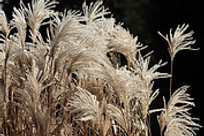
Creeping Grasses:
Creeping grasses spread by rhizomes. They produce long rhizomes that rapidly form large colonies. They are quite invasive. The common reed grasses seen in roadside ditches are of the creeping variety. They can spread miles on end.
Look at the plant in the pot before purchasing it. If the plant has well separated stalks protruding from the pot, it is probably a creeping grass. They are hard to contain. If you choose to plant this type of grass, either plant them in an area where you wish them to spread, or contain them by planting them next to a solid barrier, or plant them in the ground in the pot.
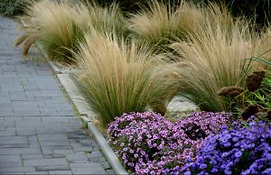
Clumping Grasses:
These grasses form in dense tufts and will not spread like creepers. They will expand their circumference in time and will need to be divided. Refer to Ornamental Grasses for more on how to divide grasses.
You can determine if the plant at your favorite nursery is of the clumping variety by looking at the stems. If it is a dense clump, it is a clumping grass.
Intermediate Group/Grasses With Short Rhizomes:
This variety will creep slightly but will not be invasive. If it starts to creep, take a spade shovel and dig out the stray stems.
5. Miscellaneous Thoughts to Consider When Purchasing Grasses
- Flood Prone Areas
If you live in a flood prone area or have low lying wet areas in your yard, particular grasses will help sop up the excess water. People also use grasses to fill in retention basins. Some varieties that do well in wet areas are Prairie Cordgrass (Spartina pectinata), and the Sugarcane Plumegrass (Erianthus giganteus ‘Red Mountain’). These varieties prefer full sun.
- Salt Spray Tolerance
Many who live close to the sea select ornamental grasses for their yards. They look especially nice in the graceful winds that are common in these settings. However, the wind will carry salt water to your garden. Below is a list of salt spray tolerant grasses.
- Bouteloua curtipendula.
- Bouteloua gracilis.
- Deschampsia cespitosa.
- Eragrostis spectabilis.
- Schizachyrium scoparium.
- Sporobolus heterolepis.
Be sure to read the tag before purchasing grasses.
- Tree Root Competition
One last item to consider when purchasing grasses is whether or not they will tolerate competition with trees with shallow roots. It will be difficult to plant a new ornamental grass close to an established tree. It is best to plant a tree in its infant stage and the ornamental grass at the same time. However, be sure it will not have to compete the root growth of the tree. Inquire at the nursery to see if this will create problems down the road.
When Should You Plant Ornamental Grasses?
If you live in an area with harsh winters, plant your grasses in the early spring. This allows them to establish their roots before winter sets in.
If you live in a milder area you can plant the grasses in the fall.
Planting ornamental grasses is rather easy. Dig a hole twice its size and depth.
Add a little Miracle Gro All Purpose Garden Soil (click here to purchase on Amazon) to the hole and mix it with the soil. This will give the plant a boost of nutrients to establish well-growing roots.
Be sure to uncurl the root ball if the plant is root bound before placing it into the ground. Gently unravel the roots and place them in the hole.
The top of the root ball should be even with the level of the surrounding soil. Refill the hole with the amended soil and water well.
Apply some natural mulch (not dyed) on top of the soil but not touching the plant’s stalks. Leave a little space between the mulch and the plant to prevent fungi and insects from infecting the newly planted grass.
For more information on ornamental grasses, click here Ornamental Grasses.
Where Should You Add Ornamental Grasses to Your Landscape?
Ornamental grasses have many functions. They can be used as an accent plant, a border, or to anchor tall trees. One other reason to include ornamental grasses in your landscape is to add whimsy and character to your yard. They will complement Asian, traditional or modern gardens. Here are a few tips on where and why you can incorporate grasses in your landscape.
1.Add for Autumn Interest.
When it is starting to look a little droopy and tired, it’s nice to see a blast of color in your garden without having to purchase seasonal annuals. By planting ornamental grasses, you can include beauty and motion in your changing garden. Plant them next to summer perennials that have begun to loose their vim and vigor.

2. Use as a Border.
There may be an unsightly area in your yard that you’d like to block. Use grasses to obstruct the view. Or perhaps you would like to divide your landscape into distinct areas. Use grasses to achieve that look.
3. Add Some Texture to Your Garden.
If your garden looks a little lackluster, pop in a grass or 3 or 5 (remember to always add an odd number of flower/plants to your garden.) This will add interest to an otherwise blah spot. They look lovely with perennials, annuals and shrubs. Be sure to check the mature size of the grass and plant it in proper relationship to the surrounding foliage. Refer to Beautiful Shade Garden Ideas and Low Maintenance Flower Garden for more tips on adding plants to your garden.
4. Use as a Groundcover.
Lawn grass is overrated. You don’t need a lush perfectly green lawn in order to make your yard appealing. By not using traditional grass in your yard, you help the environment by eliminating the leaching of harmful chemicals into the groundwater.
Adding small mounding varieties of ornamental grasses as a groundcover will prevent soil erosion and weed establishment. Grasses also add beautiful color and interest, and reduce costs and the need for continuous maintenance.
5. Use Ornamental Grasses to Soften Hardscaping.
If your yard has a patio made of pavers or concrete, a pebbled path, or even a pool, add ornamental grasses to create a little softness to the area. This will add motion and a more natural look.
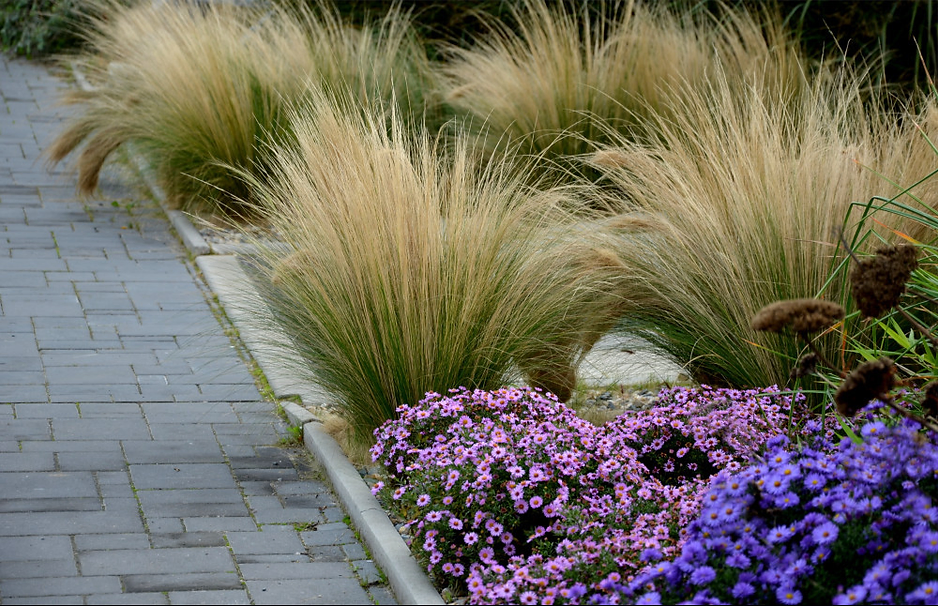
6. Use Grasses as an Accent Piece.
Consider adding the same grass scattered throughout your garden to create a more connected look.
7. Plant Grasses in Pots.
Add beauty to a patio, garden, or walkway by planting grasses in pots. Use the grass as the “thriller” in the pot. For more on decorating with pots, click here.
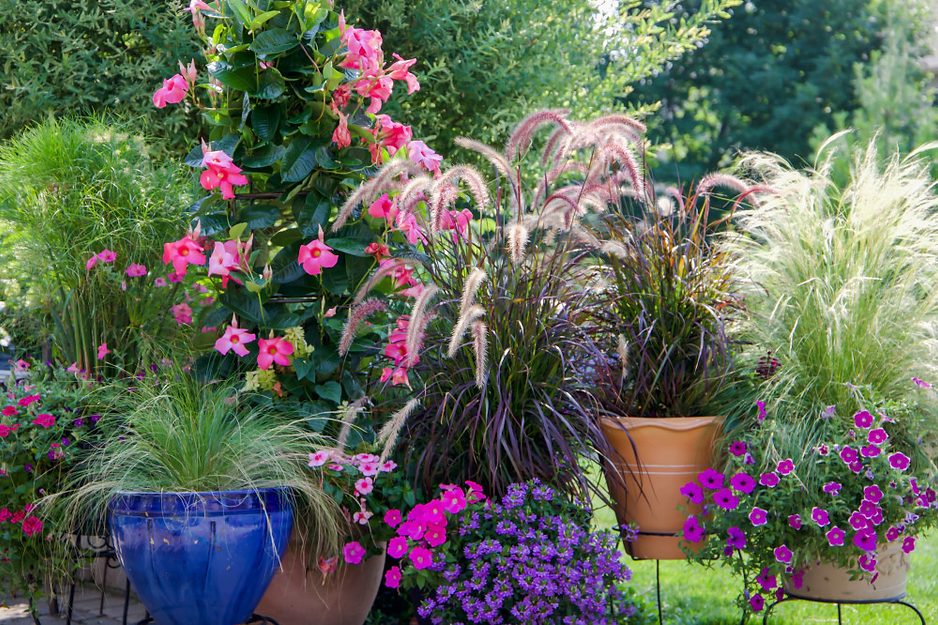
Some of My Favorite Grass Varieties
Pink Muhly Grass – wispy pink blooms that flower in the fall and winter on feather like stalks. They grow best in zones 6 through 9 and enjoy dry, well drained soil. They can be grown in full or partial sun and will grow 1 to 3 feet tall and 2 to 3 feet wide.
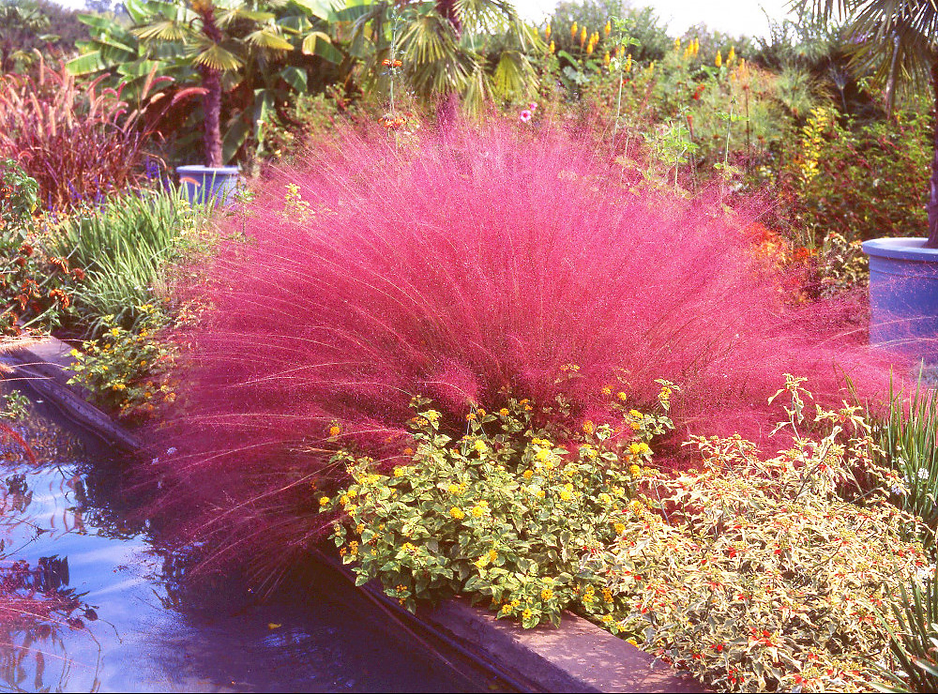
Pampas Plume White Feather Ornamental Grass – beautiful white plumes on tall stalks. It likes well drained soil and is tolerant of drought, wind, and salt spray. It is a quick grower and will extend 5 to 10 feet high and wide. Plant them 6 to 8 feet apart. It will survive in zones 6 to 11 and likes full to partial sun.
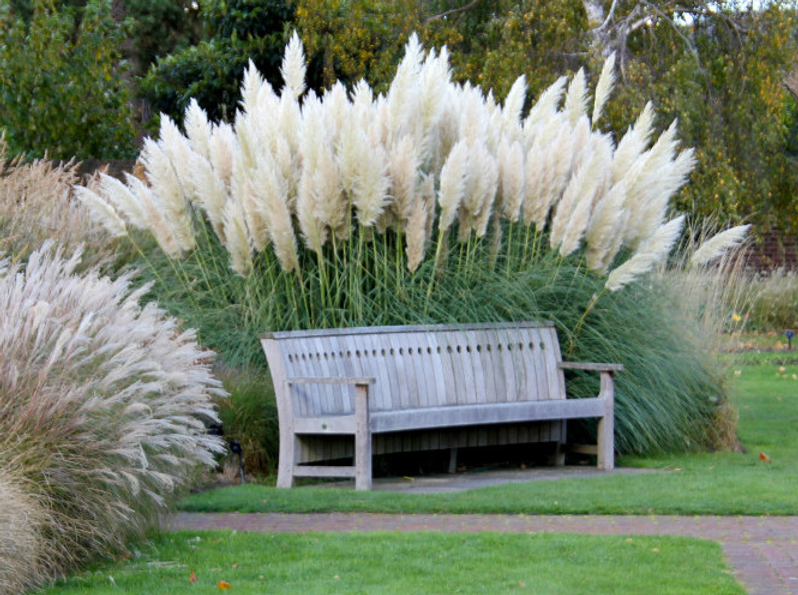
Purple Fountain Grass – fountain-like form with purple reddish plumes. Only grows in zones 9 and above, so it will not survive in cold climates. It grows from 2 to 5 feet tall and 2 to 4 feet wide. It thrives in full sun to partial shade and medium well-drained soil.

“Red Baron” /Japanese Blood Grass – upright green blades whose upper leaves turn to cranberry red in summer and turn to a deep burgundy in late fall. It is an intermediate grass that grows 12 to 18 inches tall and wide. It thrives in medium, well drained soil and full to partial sun.
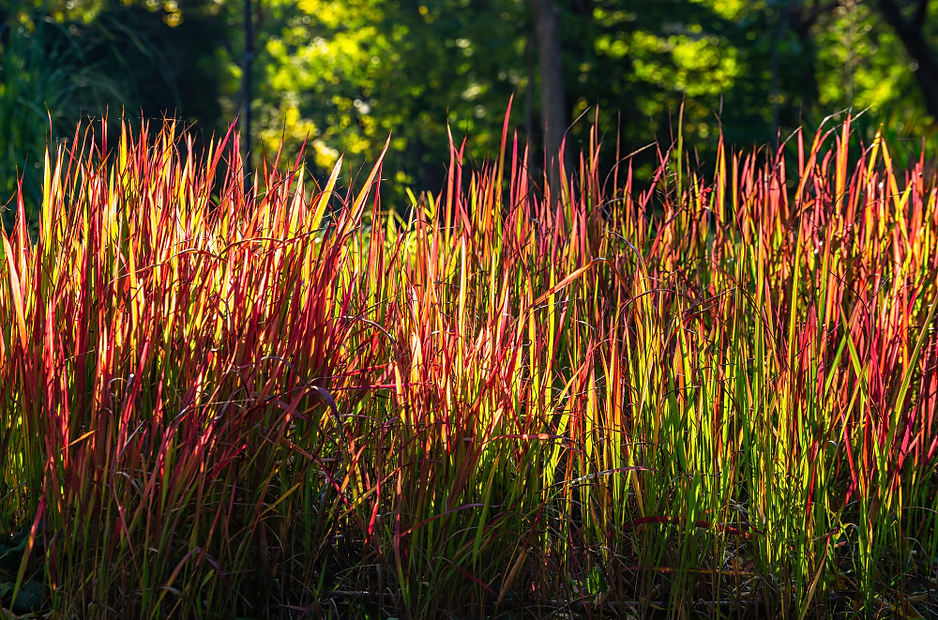
Conclusion-Landscaping With Ornamental Grasses
Ornamental grasses are currently in vogue. They add whimsy, color, and movement to a garden. By understanding the types and varieties of grasses you can create interest and beauty in an otherwise nondescript garden. Follow the suggestions mentioned in this post and you’ll be on your way to having the most beautiful garden in the neighborhood!
I hope you enjoyed this post. Please share it with others and leave a comment below. I’d love to hear from you!
Happy Gardening!
Nina

